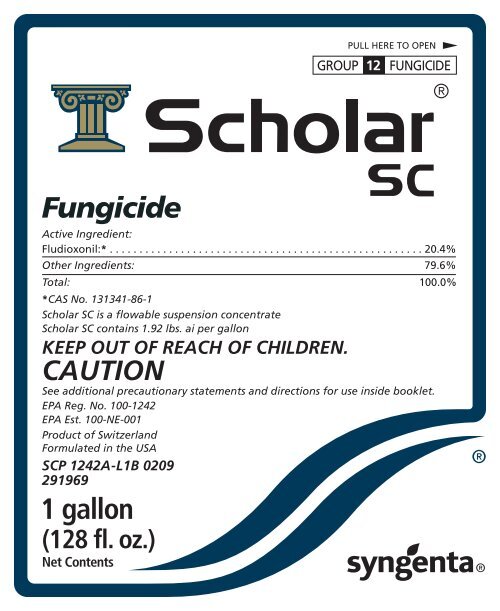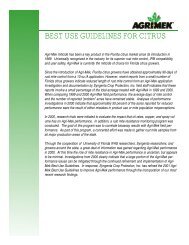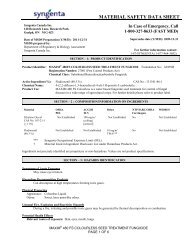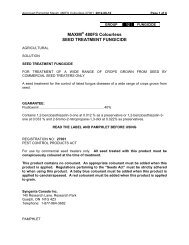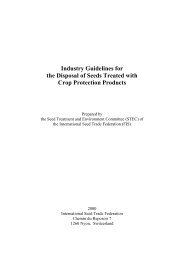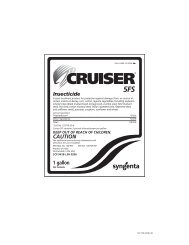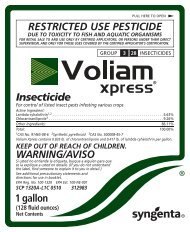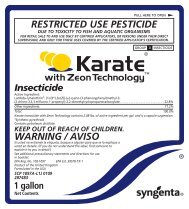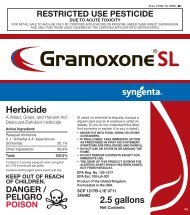Fungicide 1 gallon - Syngenta Crop Protection
Fungicide 1 gallon - Syngenta Crop Protection
Fungicide 1 gallon - Syngenta Crop Protection
Create successful ePaper yourself
Turn your PDF publications into a flip-book with our unique Google optimized e-Paper software.
<strong>Fungicide</strong><br />
PULL HERE TO OPEN<br />
GROUP 12 FUNGICIDE<br />
Active Ingredient:<br />
Fludioxonil:* . . . . . . . . . . . . . . . . . . . . . . . . . . . . . . . . . . . . . . . . . . . . . . . . . . . . . 20.4%<br />
Other Ingredients: 79.6%<br />
Total: 100.0%<br />
*CAS No. 131341-86-1<br />
Scholar SC is a flowable suspension concentrate<br />
Scholar SC contains 1.92 lbs. ai per <strong>gallon</strong><br />
KEEP OUT OF REACH OF CHILDREN.<br />
CAUTION<br />
See additional precautionary statements and directions for use inside booklet.<br />
EPA Reg. No. 100-1242<br />
EPA Est. 100-NE-001<br />
Product of Switzerland<br />
Formulated in the USA<br />
SCP 1242A-L1B 0209<br />
291969<br />
1 <strong>gallon</strong><br />
(128 fl. oz.)<br />
Net Contents
FIRST AID<br />
If in eyes: • Hold eye open and rinse slowly and gently with water for<br />
15-20 minutes. Remove contact lenses, if present, after<br />
the first 5 minutes, then continue rinsing eye.<br />
• Call a poison control center or doctor for treatment<br />
advice.<br />
If on skin: • Take off contaminated clothing.<br />
• Rinse skin immediately with plenty of water for 15-20<br />
minutes.<br />
• Call a poison control center or doctor for treatment<br />
advice.<br />
Have the product container or label with you when calling a poison control<br />
center or doctor, or going for treatment.<br />
HOT LINE NUMBER<br />
For 24 Hour Medical Emergency Assistance (Human or Animal)<br />
or Chemical Emergency Assistance (Spill, Leak, Fire, or Accident),<br />
Call<br />
1-800-888-8372<br />
PRECAUTIONARY STATEMENTS<br />
Hazards to Humans and Domestic Animals<br />
CAUTION<br />
Causes moderate eye irritation. Harmful if absorbed through skin. Avoid<br />
contact with eyes, skin, or clothing. Remove and wash contaminated clothing<br />
before reuse. Wash thoroughly with soap and water after handling and<br />
before eating, drinking, chewing gum, using tobacco or using the toilet.<br />
Environmental Hazards<br />
This product is toxic to fish and aquatic invertebrates. Do not contaminate<br />
water when disposing of equipment wash waters or rinsates.<br />
Physical or Chemical Hazards<br />
Do not use or store near heat or open flame.
CONDITIONS OF SALE AND LIMITATION OF<br />
WARRANTY AND LIABILITY<br />
NOTICE: Read the entire Directions for Use and Conditions of Sale and<br />
Limitation of Warranty and Liability before buying or using this product.<br />
If the terms are not acceptable, return the product at once, unopened,<br />
and the purchase price will be refunded.<br />
The Directions for Use of this product must be followed carefully. It is<br />
impossible to eliminate all risks inherently associated with the use of this<br />
product. <strong>Crop</strong> injury, ineffectiveness or other unintended consequences may<br />
result because of such factors as manner of use or application, weather or<br />
crop conditions, presence of other materials or other influencing factors in<br />
the use of the product, which are beyond the control of SYNGENTA CROP<br />
PROTECTION, Inc. or Seller. To the extent permitted by applicable law, Buyer<br />
and User agree to hold SYNGENTA and Seller harmless for any claims relating<br />
to such factors.<br />
SYNGENTA warrants that this product conforms to the chemical description<br />
on the label and is reasonably fit for the purposes stated in the Directions<br />
for Use, subject to the inherent risks referred to above, when used in accordance<br />
with directions under normal use conditions. To the extent permitted<br />
by applicable law: (1) this warranty does not extend to the use of the product<br />
contrary to label instructions or under conditions not reasonably foreseeable<br />
to or beyond the control of Seller or SYNGENTA, and, (2) Buyer and User<br />
assume the risk of any such use. TO THE EXTENT PERMITTED BY APPLICABLE<br />
LAW, SYNGENTA MAKES NO WARRANTIES OF MERCHANTABILITY OR OF<br />
FITNESS FOR A PARTICULAR PURPOSE NOR ANY OTHER EXPRESS OR IMPLIED<br />
WARRANTY EXCEPT AS WARRANTED BY THIS LABEL.<br />
To the extent permitted by applicable law, in no event shall SYNGENTA be<br />
liable for any incidental, consequential or special damages resulting from the<br />
use or handling of this product. TO THE EXTENT PERMITTED BY APPLICABLE<br />
LAW, THE EXCLUSIVE REMEDY OF THE USER OR BUYER, AND THE EXCLUSIVE<br />
LIABILITY OF SYNGENTA AND SELLER FOR ANY AND ALL CLAIMS, LOSSES,<br />
INJURIES OR DAMAGES (INCLUDING CLAIMS BASED ON BREACH OF WAR-<br />
RANTY, CONTRACT, NEGLIGENCE, TORT, STRICT LIABILITY OR OTHERWISE)<br />
RESULTING FROM THE USE OR HANDLING OF THIS PRODUCT, SHALL BE THE<br />
RETURN OF THE PURCHASE PRICE OF THE PRODUCT OR, AT THE ELECTION<br />
OF SYNGENTA OR SELLER, THE REPLACEMENT OF THE PRODUCT.
SYNGENTA and Seller offer this product, and Buyer and User accept it,<br />
subject to the foregoing Conditions of Sale and Limitation of Warranty and<br />
Liability, which may not be modified except by written agreement signed by<br />
a duly authorized representative of SYNGENTA.<br />
DIRECTIONS FOR USE<br />
It is a violation of Federal law to use this product in a manner inconsistent<br />
with its labeling.<br />
For any requirements specific to your State or Tribe, consult the State or<br />
Tribal agency responsible for pesticide regulation.<br />
Do not formulate this product into other End-use products.<br />
GENERAL INFORMATION<br />
FAILURE TO FOLLOW THE DIRECTIONS FOR USE AND PRECAUTIONS ON THIS<br />
LABEL MAY RESULT IN POOR DISEASE CONTROL.<br />
GROUP 12<br />
FUNGICIDE<br />
Scholar SC is a protective fungicide used to aid in the control of several post<br />
harvest diseases in post-harvest treatment facilities. Scholar SC contains<br />
fludioxonil that is in the phenylpyrrole class of chemistry and has a unique<br />
mode of action, which leads to increased glycerol synthesis [<strong>Fungicide</strong> Action<br />
Group 12]. Fungal isolates with acquired resistance to Group 12 may eventually<br />
dominate the fungal population if Group 12 fungicides are used repeatedly<br />
in the same field or in successive years as the primary method of control<br />
for targeted species. This may result in partial or total loss of control of those<br />
species by fludioxonil or other Group 12 fungicides. A disease management<br />
program that includes alternation or tank mixes between Scholar SC and<br />
other labeled fungicides that have a different mode of action may prevent<br />
pathogen populations from developing resistance. Sanitation and other cultural<br />
practices to minimize disease are also recommended to aid in control<br />
as well as to assist in preventing/delaying resistance development.<br />
NOTE: Scholar SC may be degraded by exposure to direct sunlight. Treated<br />
fruit should not be stored in direct sunlight.
MIXING PROCEDURES<br />
Vigorously shake the product container before mixing. Prepare no more<br />
spray mixture than is needed for the immediate operation. Thoroughly clean<br />
spray equipment before using this product. Vigorous agitation is necessary<br />
for proper dispersal of the product. Maintain maximum agitation throughout<br />
the spraying operation. Do not let the spray mixture stand overnight in<br />
the spray tank. Flush the spray equipment thoroughly following each use.<br />
To determine the physical compatibility of Scholar SC with other products,<br />
use a jar test as described below.<br />
Jar Compatibility Test: Using a quart jar, add the proportionate amounts of<br />
the products to 1 qt. of water or wax/oil emulsion. Add wettable powders<br />
and water-dispersible granular products first, then liquid flowables, and<br />
emulsifiable concentrates last. After thoroughly mixing, let stand for at least<br />
5 minutes. If the combination remains mixed or can be remixed readily, it<br />
is physically compatible. Once compatibility has been proven, use the same<br />
procedure for adding required ingredients to the spray tank.<br />
If using Scholar SC in a tank mixture, observe all directions for use, crops/<br />
sites, use rates, dilution ratios, precautions, and limitations which appear<br />
on the tank mix product label. No label dosage rate may be exceeded and<br />
the most restrictive label precautions and limitations must be followed. This<br />
product must not be mixed with any product which prohibits such mixing.<br />
Tank mixtures are permitted only in those states where the tank mix partner<br />
is registered.<br />
THE CROP SAFETY OF ALL POTENTIAL TANK MIXES INCLUDING ADDITIVES<br />
AND OTHER PESTICIDES ON ALL CROPS HAS NOT BEEN TESTED. BEFORE<br />
APPLYING ANY TANK MIXTURE, THE SAFETY TO THE TARGET CROP SHOULD<br />
BE CONFIRMED.<br />
Add 1 /2 of the required amount of water or wax/oil emulsion (or aqueous<br />
dilution of a wax/oil emulsion) to the spray or mixing tank. With the agitator<br />
running, open the container and add the Scholar SC to the tank. Continue<br />
agitation while adding the remainder of the carrier. Begin application of the<br />
solution after the Scholar SC has completely and uniformly dispersed into the<br />
mix carrier. Maintain agitation until all of the mixture has been applied.
If tank-mixing, add the desired amount of other products recommended for<br />
tank mixture after Scholar SC has completely and uniformly dispersed into<br />
the mix carrier. In general, tank mix partners should be added in this order:<br />
wettable powders, wettable granules (dry flowables), liquid flowables,<br />
liquids, and emulsifiable concentrates. Always allow each tank mix partner<br />
to become fully dispersed before adding the next product. Continue agitation<br />
to maintain a uniform suspension until all of the spray solution has<br />
been applied. Maintain agitation until all of the mixture has been applied.<br />
CROP USE DIRECTIONS<br />
Kiwi<br />
Use Scholar SC as a post-harvest dip or spray for the control of Botrytis fruit<br />
rot in kiwi.<br />
Application<br />
Method Disease Rate (fl. oz.) Remarks<br />
In-Line Dip/Drench Botrytis fruit rot 16-32 fl. oz./<br />
100 gals.<br />
In-line Aqueous or<br />
Fruit Coating Spray<br />
application<br />
Botrytis fruit rot 16-32 fl.<br />
oz./200,000<br />
lbs. of fruit<br />
Do not make more than one post-harvest application to the fruit.<br />
• Mix 16-32 fl. oz. of Scholar SC in<br />
100 gals. of water, wax/emulsion,<br />
or aqueous dilution of wax/oil<br />
emulsion. *Dip for approximately<br />
30 seconds and allow fruit to<br />
drain.<br />
• Ensure proper coverage of the<br />
fruit.<br />
• Mix the fungicide solution in an<br />
appropriate amount of water,<br />
wax/emulsion, or aqueous dilution<br />
of wax/oil emulsion for the<br />
crop being treated.<br />
• Ensure the Scholar SC solution remains in suspension by using agitation.<br />
• Scholar SC is stable in chlorine (100 ppm solution) and at temperatures of 60°C (or 140°F)<br />
that can be used to disinfest high-volume, recycling tanks.
Pome fruit: Apple (Malus domestica), Crabapple (Malus spp.), Loquat<br />
(Eriobotrya japonica), Mayhaw (Crataegus aestivalis, C. opaca, and<br />
C. rufula), Pear (Pyrus communis), Pear, oriental (Pyrus pyrifolia),<br />
Quince (Cydonia oblonga)<br />
Use Scholar SC as a post-harvest dip, drench, flood, or spray for the control<br />
of post-harvest diseases caused by:<br />
• Blue mold (Penicillium expansum)<br />
• Gray mold (Botrytis cinerea)<br />
• Bull’s-eye rot (Pezicula malacorticis)<br />
• Rhizopus rot (Rhizopus stolonifer)<br />
• Bitter rot (Colletotrichum gloeosporiodes)<br />
• Sphaeropsis rot (Sphaeropsis pyriputrescens)<br />
• Phacidiopycnis rot (Phacidiopycnis piri)<br />
• Speck rot (Phacidiopycnis washingtonensis)<br />
• White rot (Botryosphaeria dothidea)<br />
Application<br />
Method Disease Rate (fl. oz.) Remarks<br />
Bin/Truck Drench<br />
or<br />
In-Line Dip/Drench<br />
or Flooder<br />
Blue mold<br />
Gray mold<br />
Rhizopus rot<br />
Bull’s-eye rot<br />
Bitter rot<br />
Sphaeropsis rot<br />
Phacidiopycnis rot<br />
Speck rot<br />
White rot<br />
10-16 fl. oz./<br />
100 gals.<br />
16 fl. oz./<br />
100 gals.<br />
• Ensure proper coverage of<br />
the fruit.<br />
• For re-cycling in-line drench<br />
or dip treatments, the fungicide<br />
solution may be prepared<br />
in water.<br />
• For in-line drench or dip<br />
applications, treat fruit for<br />
15-30 seconds and allow fruit<br />
to drain.<br />
• Fruit coatings may be applied<br />
separately after aqueous fungicide<br />
treatments.
Application<br />
Method Disease Rate (fl. oz.) Remarks<br />
In-line Aqueous or<br />
Fruit Coating Spray<br />
application<br />
Blue mold<br />
Gray mold<br />
Rhizopus rot<br />
Bull’s-eye rot<br />
Bitter rot<br />
Sphaeropsis rot<br />
Phacidiopycnis rot<br />
White rot<br />
16-32 fl. oz./<br />
200,000 lbs. of<br />
fruit<br />
• Ensure proper coverage of<br />
the fruit.<br />
• Mix the fungicide solution<br />
in an appropriate water,<br />
wax/oil emulsion, or aqueous<br />
dilution of a wax/<br />
oil emulsion for the crop<br />
being treated.<br />
• Use T-jet, CDA, or similar<br />
application system.<br />
Do not make more than two applications to pome fruit. For maximum decay control,<br />
treat fruit once before storage and once after storage, just prior to marketing.<br />
• Ensure the Scholar SC solution remains in suspension by using agitation.<br />
• Scholar SC is stable in chlorine (100 ppm solution) and at temperatures of 60°C (or 140°F)<br />
that can be used to disinfest high-volume, recycling tanks.<br />
Pomegranates<br />
Use Scholar SC as a post-harvest dip for the control of Botrytis fruit rot in<br />
pomegranates.<br />
Application<br />
Method Disease<br />
In-Line Dip/<br />
Drench<br />
Botrytis fruit rot 32 fl. oz./<br />
100 gals.<br />
Rate<br />
(fl. oz.) Remarks<br />
Do not make more than one post-harvest application to the fruit.<br />
• Mix 32 fl. oz. of Scholar SC in 100 gals.<br />
of water, wax/emulsion, or aqueous<br />
dilution of wax/oil emulsion. *Dip for<br />
approximately 30 seconds and allow<br />
fruit to drain.<br />
• Dip solution should be replaced with<br />
fresh dip solution after 200,000<br />
pounds of fruit has been treated.<br />
• Ensure the Scholar SC solution remains in suspension by using agitation.<br />
• Scholar SC is stable in chlorine (100 ppm solution) and at temperatures of 60°C (or 140°F)<br />
that can be used to disinfest high-volume, recycling tanks.
Stone Fruit: Apricot (Prunus armeniaca), Nectarine (Prunus persica),<br />
Peach (Prunus persica), Plum (Prunus domestica, Prunus spp.), Plum,<br />
Chickasaw (Prunus angustifolia), Plum, Damson (Prunus domestica<br />
spp. insititia), Plum, Japanese (Prunus salicina), Plumcot (Prunus<br />
armeniaca × P. domestica), Prune (fresh), (Prunus domestica, Prunus<br />
spp.), as well as other cultivars and hybrids of these.<br />
Use Scholar SC as a post-harvest dip or spray for the control of post-harvest<br />
diseases caused by:<br />
• Brown rot (Monilinia spp.)<br />
• Gray mold (Botrytis cinerea)<br />
• Rhizopus rot (Rhizopus stolonifier)<br />
• Gilbertella rot (Gilbertella persicaria)<br />
Application<br />
Method Disease Rate (fl. oz.) Remarks<br />
In-Line Dip/<br />
Drench<br />
In-line Aqueous<br />
or Fruit Coating<br />
Spray<br />
application<br />
Brown rot<br />
Gray mold<br />
Rhizopus rot<br />
Gilbertella rot<br />
Brown rot<br />
Gray mold<br />
Rhizopus rot<br />
Gilbertella rot<br />
16 fl. oz./<br />
100 gals.<br />
16-32 fl. oz./<br />
200,000 lbs.<br />
of fruit<br />
Do not make more than one post-harvest application to the fruit.<br />
• Mix 16 fl. oz. of Scholar SC in 100<br />
gals. of water, wax/emulsion, or aqueous<br />
dilution of wax/oil emulsion.<br />
• Dip for approximately 30 seconds and<br />
allow fruit to drain.<br />
• Dip solution should be replaced with<br />
fresh dip solution after 200,000<br />
pounds of fruit has been treated.<br />
• Ensure proper coverage of the fruit.<br />
• Mix 16-32 fl. oz. of Scholar SC in an<br />
appropriate water, wax/oil emulsion,<br />
or aqueous dilution of a wax/oil<br />
emulsion for the crop being treated.<br />
• Use T-Jet, CDA, or similar application<br />
system.<br />
• For maximum efficacy, use low volume<br />
concentrate application systems<br />
for treatment of plums.<br />
• Ensure the Scholar SC solution remains in suspension by using agitation.<br />
• Scholar SC is stable in chlorine (100 ppm solution) and at temperatures of 60°C (or 140°F)<br />
that can be used to disinfest high-volume, recycling tanks.
Cherries: Cherry, sweet (Prunus avium), Cherry, tart (Prunus cerasus), as well<br />
as other cultivars and hybrids of these.<br />
Application<br />
Method Disease Rate (fl. oz.) Remarks<br />
In-line Aqueous<br />
or flooder<br />
application<br />
High-Volume<br />
(dilute-spray)<br />
application<br />
Brown rot<br />
Gray mold<br />
Rhizopus rot<br />
Gilbertella rot<br />
16-32 fl. oz./<br />
50,000 lbs. of<br />
fruit<br />
Do not make more than one post-harvest application to the fruit.<br />
• Ensure the Scholar SC solution remains in suspension by using agitation.<br />
• Mix 16 fl. oz. of Scholar SC in 50-100<br />
gals. or 32 fl. oz. of Scholar SC in 100<br />
gals. of an appropriate water, wax/<br />
emulsion, or aqueous dilution of a<br />
wax/oil emulsion.<br />
• Use flooders, T-jet, or similar application<br />
system.<br />
True Yam<br />
Use Scholar SC as a post-harvest dip for the control of certain post-harvest<br />
rots caused by Penicillium and Fusarium species.<br />
Application<br />
Method Disease Rate (fl. oz.) Remarks<br />
Post Harvest Dip<br />
Application<br />
Brown rot<br />
Gray mold<br />
Rhizopus rot<br />
Gilbertella rot<br />
16-32 fl.<br />
oz./100 gals<br />
Do not make more than one post-harvest application to the tubers.<br />
• Ensure the Scholar SC solution remains in suspension by using agitation.<br />
• Mix 16-32 fl. oz. of Scholar SC in 100<br />
gals. of an appropriate water, wax/<br />
emulsion, or aqueous dilution of wax/<br />
oil emulsion.<br />
• Dip for approximately 30 seconds and<br />
allow fruit to drain.<br />
NOTE: Ensure the Scholar SC solution remains in suspension by using agitation.<br />
Scholar SC may be degraded by exposure to direct sunlight. Treated fruit should<br />
not be stored in direct sunlight.
Sweet Potato<br />
Use Scholar SC as a post-harvest dip and low volume application for the<br />
control of post-harvest rots caused by Rhizopus stolonifer.<br />
Application<br />
Method Disease Rate (fl. oz.) Remarks<br />
In-Line Dip/<br />
Drench<br />
In-line Aqueous<br />
or Fruit Coating<br />
Spray application<br />
Rhizopus rot 16-32 fl.<br />
oz./100 gals.<br />
Rhizopus rot 16 fl. oz./<br />
200,000 lbs. of<br />
sweet potatoes<br />
• Mix 16-32 fl. oz. of Scholar SC in 100<br />
gals. of water, wax/emulsion, or aqueous<br />
dilution of wax/oil emulsion.<br />
• Dip for approximately 30 seconds and<br />
allow fruit to drain.<br />
• Add 8 fl. oz. of Scholar SC to 100<br />
gals. of treating suspension after 500<br />
bushels are treated.<br />
• After each 1000 bushels treated,<br />
drain and flush the tank. Refill with<br />
fresh dip suspension.<br />
• Ensure proper coverage of the fruit.<br />
• Mix 16 fl. oz. of Scholar SC in an<br />
appropriate water, wax/oil emulsion,<br />
or aqueous dilution of a wax/oil emulsion<br />
for the crop being treated.<br />
• Use T-Jet, CDA, or similar application<br />
system.<br />
Do not make more than one post-harvest application to the sweet potatoes.<br />
• Ensure the Scholar SC solution remains in suspension by using agitation.<br />
• Scholar SC is stable in chlorine (100 ppm solution) and at temperatures of 60°C (or 140°F)<br />
that can be used to disinfest high-volume, recycling tanks.<br />
NOTE: Ensure the Scholar SC solution remains in suspension by using agitation.<br />
Scholar SC may be degraded by exposure to direct sunlight. Treated sweet<br />
potatoes should not be stored in direct sunlight.
STORAGE AND DISPOSAL<br />
Do not contaminate water, food or feed by storage or disposal.<br />
Pesticide Storage<br />
Do not store near heat or open flame. Store in original containers only.<br />
Keep container closed when not in use. Do not store near food or feed. In<br />
case of spill on floor or paved surfaces, mop and remove to chemical waste<br />
storage area until proper disposal can be made if product cannot be used<br />
according to the label. Take special care to avoid contamination of equipment<br />
and facilities during cleanup procedures and disposal of wastes.<br />
Pesticide Disposal<br />
Improper disposal of unused pesticide, spray mixture, or rinsate is a violation<br />
of federal law. If these wastes cannot be disposed of by use according<br />
to label instructions, contact your State Pesticide or Environmental<br />
Control Agency, or the Hazardous Waste representative of the nearest<br />
EPA Regional Office for guidance.<br />
Container Disposal<br />
Plastic Containers: Triple rinse (or equivalent). Then offer for recycling<br />
or reconditioning, or puncture and dispose of in a sanitary landfill, or<br />
incineration, or, if allowed by state and local authorities, by burning. If<br />
burned, stay out of smoke.<br />
For Bulk or Minibulk Containers:<br />
Container Disposal: Reseal container and offer for reconditioning, or<br />
triple rinse (or equivalent) and offer for recycling or reconditioning.<br />
Container Precautions: Before refilling, inspect thoroughly for damage,<br />
such as cracks, punctures, bulges, dents, abrasions and damaged or worn<br />
threads on closure devices.<br />
Refill only with Scholar SC. The contents of this container cannot be completely<br />
removed by cleaning. Refilling with materials other than Scholar<br />
SC will result in contamination and may weaken container. After filling<br />
and before transporting, check for leaks. Do not refill or transport damaged<br />
or leaking container.<br />
CONTAINER IS NOT SAFE FOR FOOD, FEED OR DRINKING WATER.
Scholar®, the <strong>Syngenta</strong> logo and the CP FRAME are trademarks of a<br />
<strong>Syngenta</strong> Group Company.<br />
©2009 <strong>Syngenta</strong><br />
For non-emergency (e.g., current product information), call<br />
<strong>Syngenta</strong> <strong>Crop</strong> <strong>Protection</strong> at 1-800-334-9481.<br />
Manufactured for:<br />
<strong>Syngenta</strong> <strong>Crop</strong> <strong>Protection</strong>, Inc.<br />
P.O. Box 18300<br />
Greensboro, North Carolina 27419-8300<br />
SCP 1242A-L1B 0209<br />
291969
BAR CODE # IS<br />
(01) 0 07 02941 38611<br />
LAST DIGIT IS CHECK DIGIT<br />
(Barcode type: UCC/EAN 128)<br />
GROUP 12 FUNGICIDE<br />
<strong>Fungicide</strong><br />
Active Ingredient:<br />
Fludioxonil:* . . . . . . . . . . . . . . . . . . 20.4%<br />
Other Ingredients: 79.6%<br />
Total: 100.0%<br />
*CAS No. 131341-86-1<br />
Scholar SC is a flowable suspension<br />
concentrate<br />
Scholar SC contains 1.92 lbs. ai per <strong>gallon</strong><br />
See additional precautionary statements<br />
and directions for use in booklet.<br />
EPA Reg. No. 100-1242<br />
EPA Est. 100-NE-001<br />
Product of Switzerland<br />
Formulated in the USA<br />
Scholar® and the <strong>Syngenta</strong> logo are trademarks<br />
of a <strong>Syngenta</strong> Group Company.<br />
©2009 <strong>Syngenta</strong><br />
Manufactured for:<br />
<strong>Syngenta</strong> <strong>Crop</strong> <strong>Protection</strong>, Inc.<br />
P. O. Box 18300<br />
Greensboro, North Carolina 27419-8300<br />
SCP 1242A-L1B 0209<br />
291969<br />
1 <strong>gallon</strong><br />
(128 fl. oz.)<br />
Net Contents<br />
KEEP OUT OF<br />
REACH OF<br />
CHILDREN.<br />
CAUTION<br />
FIRST AID<br />
If in eyes: Hold eye open and rinse<br />
slowly and gently with water for<br />
15-20 minutes. Remove contact<br />
lenses, if present, after the first 5<br />
minutes, then continue rinsing eye.<br />
Call a poison control center or doctor<br />
for treatment advice.<br />
If on skin: Take off contaminated<br />
clothing. Rinse skin immediately<br />
with plenty of water for 15-20<br />
minutes. Call a poison control center<br />
or doctor for treatment advice.<br />
Have the product container or label<br />
with you when calling a poison<br />
control center or doctor, or going<br />
for treatment.<br />
HOT LINE NUMBER: For 24 Hour<br />
Medical Emergency Assistance<br />
(Human or Animal) or Chemical<br />
Emergency Assistance (Spill, Leak,<br />
Fire, or Accident), Call 1-800-888-<br />
8372.<br />
PRECAUTIONARY<br />
STATEMENTS<br />
Hazards to Humans and<br />
Domestic Animals<br />
CAUTION<br />
Causes moderate eye irritation.<br />
Harmful if absorbed through skin.<br />
Avoid contact with eyes, skin, or<br />
clothing. Remove and wash contaminated<br />
clothing before reuse.<br />
Wash thoroughly with soap and<br />
water after handling and before<br />
eating, drinking, chewing gum,<br />
using tobacco or using the toilet.<br />
Environmental Hazards:<br />
This product is toxic to fish and<br />
aquatic invertebrates. Do not contaminate<br />
water when disposing of<br />
equipment wash waters or rinsates.<br />
STORAGE AND<br />
DISPOSAL<br />
Do not contaminate water,<br />
food or feed by storage or<br />
disposal.<br />
Pesticide Storage<br />
Do not store near heat or open<br />
flame. Store in original containers<br />
only. Keep container closed<br />
when not in use. Do not store<br />
near food or feed. In case of<br />
spill on floor or paved surfaces,<br />
mop and remove to chemical<br />
waste storage area until<br />
proper disposal can be made if<br />
product cannot be used according<br />
to the label. Take special<br />
care to avoid contamination of<br />
equipment and facilities during<br />
cleanup procedures and disposal<br />
of wastes.<br />
Pesticide Disposal<br />
Improper disposal of unused<br />
pesticide, spray mixture, or<br />
rinsate is a violation of federal<br />
law. If these wastes cannot<br />
be disposed of by use<br />
according to label instructions,<br />
contact your State Pesticide or<br />
Environmental Control Agency,<br />
or the Hazardous Waste representative<br />
of the nearest EPA<br />
Regional Office for guidance.<br />
Container Disposal<br />
Plastic Containers: Triple<br />
rinse (or equivalent). Then offer<br />
for recycling or reconditioning,<br />
or puncture and dispose of in<br />
a sanitary landfill, or incineration,<br />
or, if allowed by state and<br />
local authorities, by burning. If<br />
burned, stay out of smoke.<br />
CONTAINER IS NOT SAFE FOR<br />
FOOD, FEED OR DRINKING<br />
WATER.


